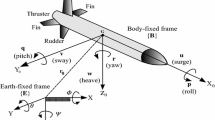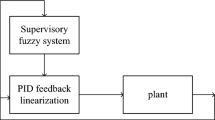Abstract
This paper focuses on design of a new self-adaptive fuzzy PID controller based on nonlinear MIMO structure for an AUV. Complexity and highly coupled dynamics, time-variance, and difficulty in hydrodynamic modeling and simulation, complicates the AUV modeling process and the design of proper and acceptable controller. In this work, the comprehensive nonlinear model of AUV is derived through kinematics and dynamic equations and then its treatment in open-loop is verified. In proposed controller, the PID parameters are adjusted by Mamdani fuzzy rules. Combined adaptive methods and dual PID controllers can improve solving of the uncertainty challenge in the PID parameters and AUV modeling uncertainty. The simulation results indicate that developed control system is stable, competent, and efficient enough to control the AUV in tracking the two channels of heading and depth with stabilized speed. Obtained results show that the proposed controller is not only robust, but also gives excellent dynamic, stunning steady-state characteristics and robust stability compared with a classically tuned PID controller.























Similar content being viewed by others
References
Farrell JA, Pang S, Li W, Arrieta R (2004) Biologically inspired chemical plume tracing demonstrated on an autonomous underwater vehicle, Man, and Cybernetics Conference, September 2004, Hague, Netherlands
Yildiz O, Gokalp RB, Yilmaz AE (2009) A review on motion control of the Underwater Vehicles. In: Proceedings of electrical and electronics engineering, 2009. ELECO 2009, Bursa, 2009, pp 337–341
UUV programs (2007) http://ftp.fas.org/irp/program/collect/uuv.htm
Prestero T (2001) Verification of a six-degree-of-freedom simulation model for the REMUS autonomous underwater vehicle, MSc/ME Thesis, Massachusetts Institute of Technology
Geisbert JS (2007) Hydrodynamic modeling for autonomous underwater vehicles using computational and semi-empirical methods. Verginia Polytechnis Institute and State University
Yue C, Guo S, Li M (2012) ANSYS fluent-based modeling and hydrodynamic analysis for a spherical Underwater robot. In: Proceedings of 2012 IEEE international conference on mechatronics and automation, pp 1577–1581
Guo S, Mao S, Shi L, Li M (2012) Design and kinematic analysis of an amphibious spherical robot. In: Proceedings of 2012 IEEE international conference on mechatronics and automation, pp 2214–2219
Herman P (2009) Decoupled PD set-point controller for underwater vehicles. J Ocean Eng 36(6–7):529–534
Model based predictive control of AUVS for station keeping in a shallow water wave environment (2005) Naval Postgraduate School, Center for AUV search, Monterey, CA, 93943-5000
Wadoo S, Kachroo P (2010) Autonomous underwater vehicles: modeling, control design and simulation. CRC Press, edn 1
Buckham BJ, Podhorodeski RP, Soylu S (2008) A chattering-free sliding-mode controller for underwater vehicles with fault tolerant infinity-norm thrust allocation. J Ocean Eng, 35(16):1647–1659
Qi X (2014) Adaptive coordinated tracking control of multiple autonomous underwater vehicles. Ocean Eng 91:84–90
Zeinali M, Notash L (2010) Adaptive sliding mode control with uncertainty estimator for robot manipulators. Mech Mach Theory 45(1):80–90
Jun SW, Kim DW, Lee HJ (2011) Design of T-S fuzzy-model-based controller for depth control of autonomous underwater vehicles with parametric uncertainties. In: 2011 11th international conference on control, automation and systems, ICCAS 2011, Gyeonggi-do, Korea, Republic of, 2011, pp 1682–1684
Kumar N, Panwar V, Sukavanam N, Sharma SP, Borm JH (2011) Neural network-based nonlinear tracking control of kinematically redundant robot manipulators. Math Comput Model 53(9–10):1889–1901
Sun T, Pei H, Pan Y, Zhou H, Zhang C (2011) Neural network-based sliding mode adaptive control for robot manipulators. Neurocomputing 74(14–15):2377–2384
Xu B, Pandian SR, Sakagami N, Petry F (2012) Neuro-fuzzy control of underwater vehicle-manipulator systems. J Franklin Institute, 349(3):1125–1138
Medagoda L, Williams SB (2012) Model predictive control of an autonomous underwater vehicle in an in situ estimated water current profile. Oceans, Yeosu, pp 1–8
Steenson LV (2013) Experimentally varied model predictive control of a hover-capable AUV. PhD thesis, University of Southampton
Wang L (2010) Model predictive control system design and implementation using MATLAB, Springer
Steenson LV, Phillips AB, Turnock SR, Furlong ME, Rogers E (2012) Effect of measurement noise on the performance of a depth and pitch controller using the model predictive control method. Autonomous underwater vehicles (AUV), 2012 IEEE/OES, 1(8):24-27
Mohan S, Kim J (2012) Indirect adaptive control of an autonomous underwater vehicle-manipulator system for underwater manipulation tasks. Original Res Article Ocean Eng 54(1):233–243
Cooney LA (2009) Dynamic response and maneuvering strategies of a hybrid autonomous underwater vehicle in hovering. Thesis of master of science in ocean engineering, Massachusetts Institute of Technology
Yang Y, Yang W, Wu M, Yang Q, Xue Y (2010) A new type of intelligent control and automation, Jinan, Adaptive Fuzzy PID Controller. In: Proceedings of the 8th World Congress on China
Chang X, Jianhong L, Ming C et al (2007) Neural network PID adaptive control and its application. Control Eng China 14(3):284–286 (In Chinese)
Jiangjiang W, Chunfa Z, Youyin J (2008) Adaptive PID control with BP neural network self-tuning in exhaust temperature of micro gas turbine. In: Proceedings of the 2008 IEEE international conference on industrial electronics and applications, Piscataway, NJ, USA, pp 532–537
Sgarioto D (2008) Steady state trim and open loop stability analysis for the REMUS autonomous underwater vehicle. Defense Technology Agency, New Zealand Defense Force, DTA Report 254
Yang C (2007) Modular modeling and control for autonomous underwater vehicle (AUV). Thesis of master of engineering department of mechanical engineering national university of Singapore
Lin FC (2003) Adaptive fuzzy logic-based velocity observer for servo motor drives. Mechatronics 13:229–241
Subudhi B, Mukherjee K, Ghosh S (2013) A static output feedback control design for path following of autonomous underwater vehicle in vertical plane. Ocean Eng 63:72–76
Author information
Authors and Affiliations
Corresponding author
About this article
Cite this article
Khodayari, M.H., Balochian, S. Modeling and control of autonomous underwater vehicle (AUV) in heading and depth attitude via self-adaptive fuzzy PID controller. J Mar Sci Technol 20, 559–578 (2015). https://doi.org/10.1007/s00773-015-0312-7
Received:
Accepted:
Published:
Issue Date:
DOI: https://doi.org/10.1007/s00773-015-0312-7




